Analysis of Facility and Risk Management for Hospitality Operations
VerifiedAdded on 2022/09/02
|8
|1813
|14
Report
AI Summary
This report provides a comprehensive analysis of facility and risk management within the context of hospitality operations, focusing on the Indonesian-style bar and eatery, Salt & Palm. The report begins with an examination of venue design analysis, discussing key principles, the importance of sustainability, and the application of innovative technologies. It then delves into the specifics of venue design for functions, stakeholder considerations, and identifies potential deficiencies in the current design of Salt & Palm. Recommendations are provided to enhance the venue's design and operational efficiency. Furthermore, the report explores venue condition analysis (VCA), its principles, and purpose, including the challenges and benefits of effective VCA. The analysis of Salt & Palm includes discussions on cost management, innovation, and the importance of periodic assessments. The report concludes with a VCA table and recommendations for the venue. This report is a valuable resource for students and professionals seeking to understand the complexities of facility and risk management in the hospitality industry.
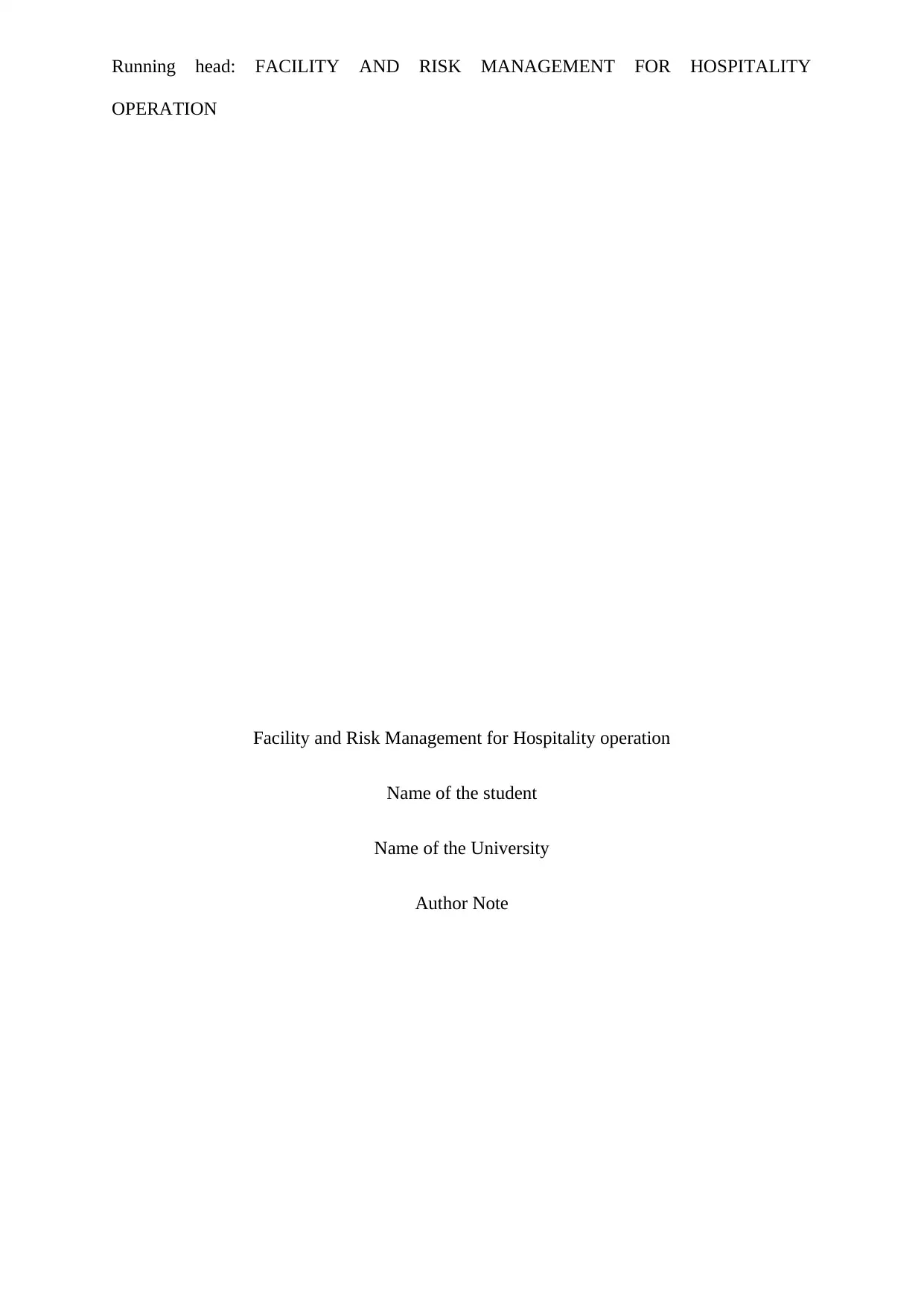
Running head: FACILITY AND RISK MANAGEMENT FOR HOSPITALITY
OPERATION
Facility and Risk Management for Hospitality operation
Name of the student
Name of the University
Author Note
OPERATION
Facility and Risk Management for Hospitality operation
Name of the student
Name of the University
Author Note
Paraphrase This Document
Need a fresh take? Get an instant paraphrase of this document with our AI Paraphraser
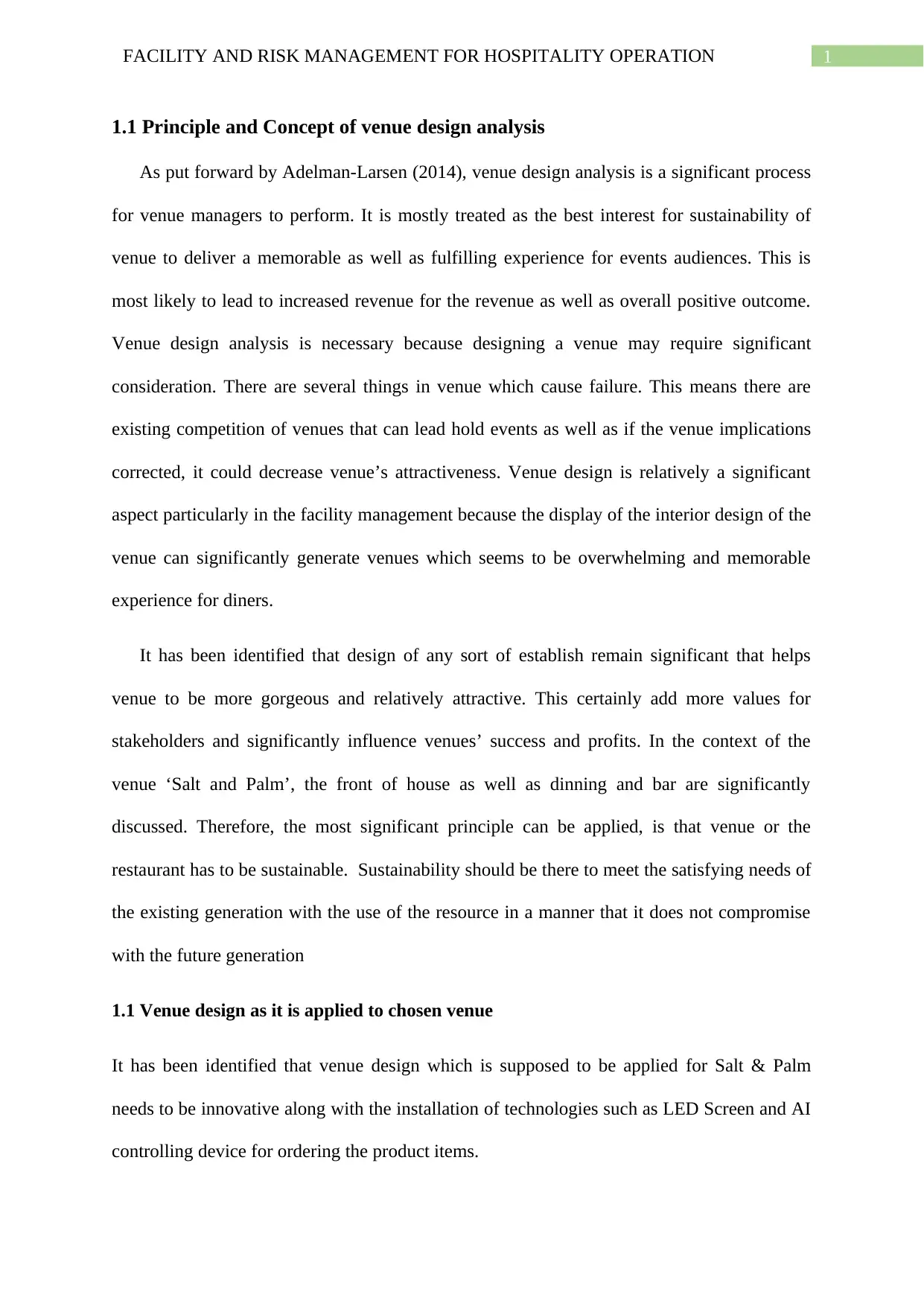
1FACILITY AND RISK MANAGEMENT FOR HOSPITALITY OPERATION
1.1 Principle and Concept of venue design analysis
As put forward by Adelman-Larsen (2014), venue design analysis is a significant process
for venue managers to perform. It is mostly treated as the best interest for sustainability of
venue to deliver a memorable as well as fulfilling experience for events audiences. This is
most likely to lead to increased revenue for the revenue as well as overall positive outcome.
Venue design analysis is necessary because designing a venue may require significant
consideration. There are several things in venue which cause failure. This means there are
existing competition of venues that can lead hold events as well as if the venue implications
corrected, it could decrease venue’s attractiveness. Venue design is relatively a significant
aspect particularly in the facility management because the display of the interior design of the
venue can significantly generate venues which seems to be overwhelming and memorable
experience for diners.
It has been identified that design of any sort of establish remain significant that helps
venue to be more gorgeous and relatively attractive. This certainly add more values for
stakeholders and significantly influence venues’ success and profits. In the context of the
venue ‘Salt and Palm’, the front of house as well as dinning and bar are significantly
discussed. Therefore, the most significant principle can be applied, is that venue or the
restaurant has to be sustainable. Sustainability should be there to meet the satisfying needs of
the existing generation with the use of the resource in a manner that it does not compromise
with the future generation
1.1 Venue design as it is applied to chosen venue
It has been identified that venue design which is supposed to be applied for Salt & Palm
needs to be innovative along with the installation of technologies such as LED Screen and AI
controlling device for ordering the product items.
1.1 Principle and Concept of venue design analysis
As put forward by Adelman-Larsen (2014), venue design analysis is a significant process
for venue managers to perform. It is mostly treated as the best interest for sustainability of
venue to deliver a memorable as well as fulfilling experience for events audiences. This is
most likely to lead to increased revenue for the revenue as well as overall positive outcome.
Venue design analysis is necessary because designing a venue may require significant
consideration. There are several things in venue which cause failure. This means there are
existing competition of venues that can lead hold events as well as if the venue implications
corrected, it could decrease venue’s attractiveness. Venue design is relatively a significant
aspect particularly in the facility management because the display of the interior design of the
venue can significantly generate venues which seems to be overwhelming and memorable
experience for diners.
It has been identified that design of any sort of establish remain significant that helps
venue to be more gorgeous and relatively attractive. This certainly add more values for
stakeholders and significantly influence venues’ success and profits. In the context of the
venue ‘Salt and Palm’, the front of house as well as dinning and bar are significantly
discussed. Therefore, the most significant principle can be applied, is that venue or the
restaurant has to be sustainable. Sustainability should be there to meet the satisfying needs of
the existing generation with the use of the resource in a manner that it does not compromise
with the future generation
1.1 Venue design as it is applied to chosen venue
It has been identified that venue design which is supposed to be applied for Salt & Palm
needs to be innovative along with the installation of technologies such as LED Screen and AI
controlling device for ordering the product items.
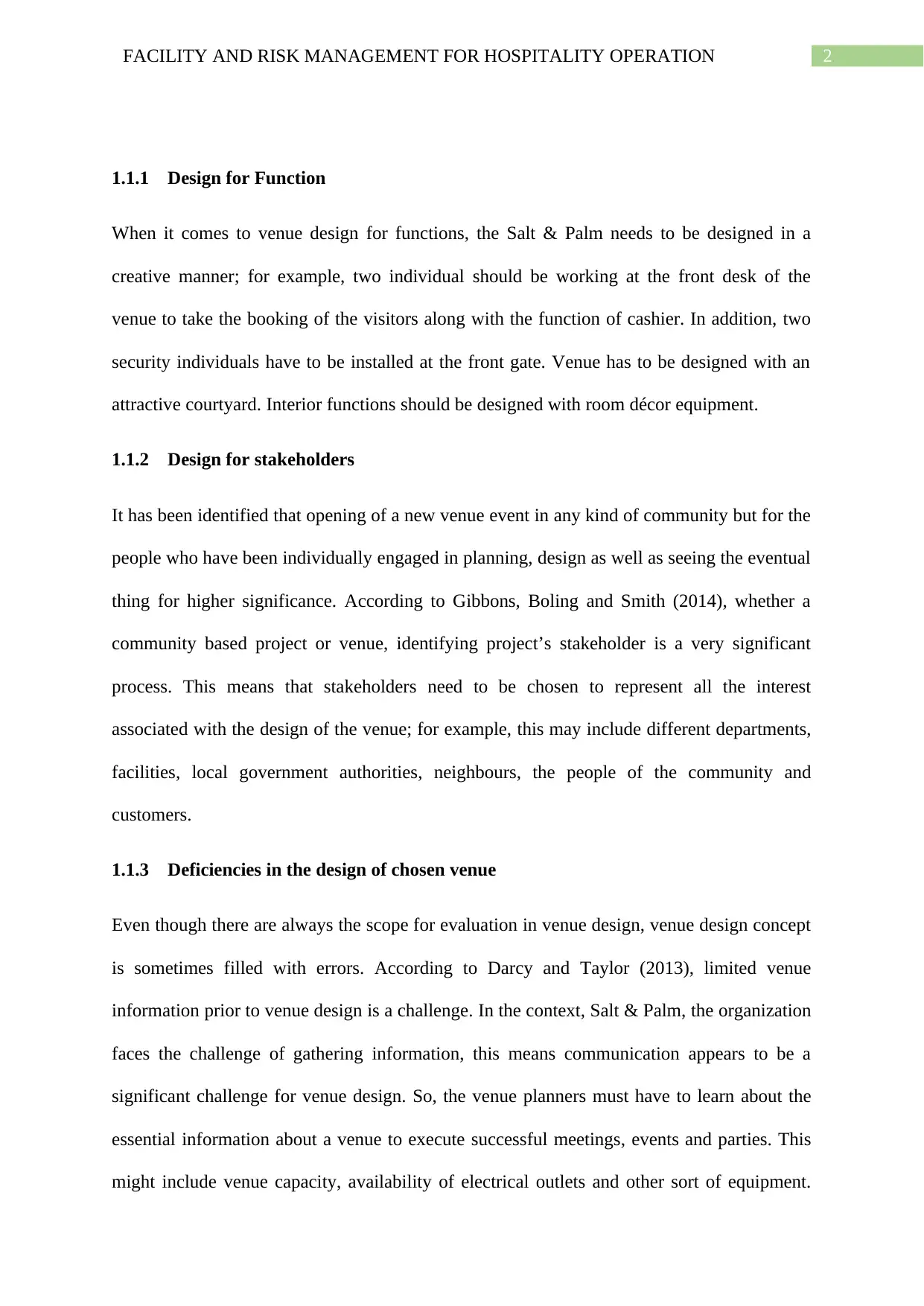
2FACILITY AND RISK MANAGEMENT FOR HOSPITALITY OPERATION
1.1.1 Design for Function
When it comes to venue design for functions, the Salt & Palm needs to be designed in a
creative manner; for example, two individual should be working at the front desk of the
venue to take the booking of the visitors along with the function of cashier. In addition, two
security individuals have to be installed at the front gate. Venue has to be designed with an
attractive courtyard. Interior functions should be designed with room décor equipment.
1.1.2 Design for stakeholders
It has been identified that opening of a new venue event in any kind of community but for the
people who have been individually engaged in planning, design as well as seeing the eventual
thing for higher significance. According to Gibbons, Boling and Smith (2014), whether a
community based project or venue, identifying project’s stakeholder is a very significant
process. This means that stakeholders need to be chosen to represent all the interest
associated with the design of the venue; for example, this may include different departments,
facilities, local government authorities, neighbours, the people of the community and
customers.
1.1.3 Deficiencies in the design of chosen venue
Even though there are always the scope for evaluation in venue design, venue design concept
is sometimes filled with errors. According to Darcy and Taylor (2013), limited venue
information prior to venue design is a challenge. In the context, Salt & Palm, the organization
faces the challenge of gathering information, this means communication appears to be a
significant challenge for venue design. So, the venue planners must have to learn about the
essential information about a venue to execute successful meetings, events and parties. This
might include venue capacity, availability of electrical outlets and other sort of equipment.
1.1.1 Design for Function
When it comes to venue design for functions, the Salt & Palm needs to be designed in a
creative manner; for example, two individual should be working at the front desk of the
venue to take the booking of the visitors along with the function of cashier. In addition, two
security individuals have to be installed at the front gate. Venue has to be designed with an
attractive courtyard. Interior functions should be designed with room décor equipment.
1.1.2 Design for stakeholders
It has been identified that opening of a new venue event in any kind of community but for the
people who have been individually engaged in planning, design as well as seeing the eventual
thing for higher significance. According to Gibbons, Boling and Smith (2014), whether a
community based project or venue, identifying project’s stakeholder is a very significant
process. This means that stakeholders need to be chosen to represent all the interest
associated with the design of the venue; for example, this may include different departments,
facilities, local government authorities, neighbours, the people of the community and
customers.
1.1.3 Deficiencies in the design of chosen venue
Even though there are always the scope for evaluation in venue design, venue design concept
is sometimes filled with errors. According to Darcy and Taylor (2013), limited venue
information prior to venue design is a challenge. In the context, Salt & Palm, the organization
faces the challenge of gathering information, this means communication appears to be a
significant challenge for venue design. So, the venue planners must have to learn about the
essential information about a venue to execute successful meetings, events and parties. This
might include venue capacity, availability of electrical outlets and other sort of equipment.
⊘ This is a preview!⊘
Do you want full access?
Subscribe today to unlock all pages.

Trusted by 1+ million students worldwide
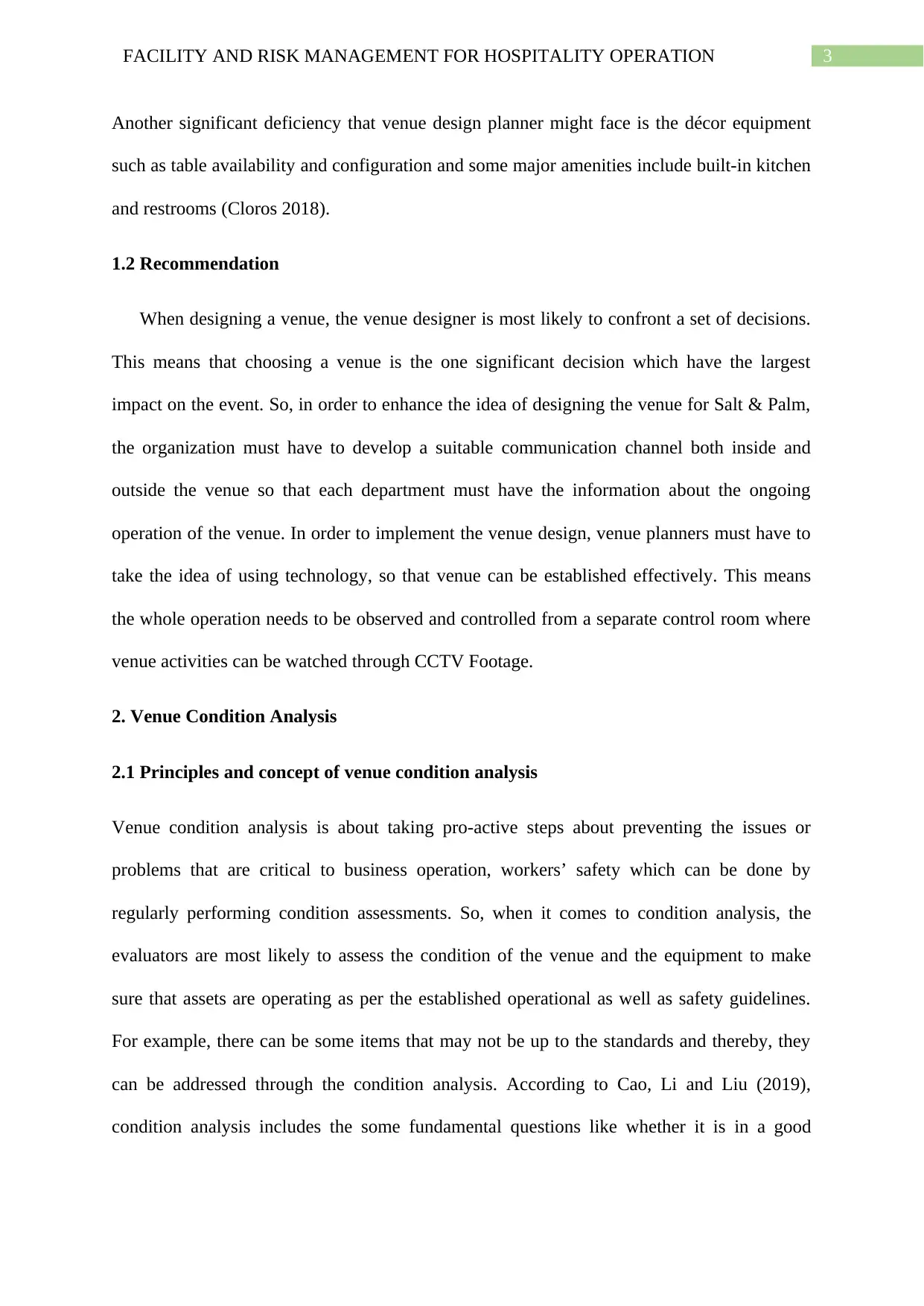
3FACILITY AND RISK MANAGEMENT FOR HOSPITALITY OPERATION
Another significant deficiency that venue design planner might face is the décor equipment
such as table availability and configuration and some major amenities include built-in kitchen
and restrooms (Cloros 2018).
1.2 Recommendation
When designing a venue, the venue designer is most likely to confront a set of decisions.
This means that choosing a venue is the one significant decision which have the largest
impact on the event. So, in order to enhance the idea of designing the venue for Salt & Palm,
the organization must have to develop a suitable communication channel both inside and
outside the venue so that each department must have the information about the ongoing
operation of the venue. In order to implement the venue design, venue planners must have to
take the idea of using technology, so that venue can be established effectively. This means
the whole operation needs to be observed and controlled from a separate control room where
venue activities can be watched through CCTV Footage.
2. Venue Condition Analysis
2.1 Principles and concept of venue condition analysis
Venue condition analysis is about taking pro-active steps about preventing the issues or
problems that are critical to business operation, workers’ safety which can be done by
regularly performing condition assessments. So, when it comes to condition analysis, the
evaluators are most likely to assess the condition of the venue and the equipment to make
sure that assets are operating as per the established operational as well as safety guidelines.
For example, there can be some items that may not be up to the standards and thereby, they
can be addressed through the condition analysis. According to Cao, Li and Liu (2019),
condition analysis includes the some fundamental questions like whether it is in a good
Another significant deficiency that venue design planner might face is the décor equipment
such as table availability and configuration and some major amenities include built-in kitchen
and restrooms (Cloros 2018).
1.2 Recommendation
When designing a venue, the venue designer is most likely to confront a set of decisions.
This means that choosing a venue is the one significant decision which have the largest
impact on the event. So, in order to enhance the idea of designing the venue for Salt & Palm,
the organization must have to develop a suitable communication channel both inside and
outside the venue so that each department must have the information about the ongoing
operation of the venue. In order to implement the venue design, venue planners must have to
take the idea of using technology, so that venue can be established effectively. This means
the whole operation needs to be observed and controlled from a separate control room where
venue activities can be watched through CCTV Footage.
2. Venue Condition Analysis
2.1 Principles and concept of venue condition analysis
Venue condition analysis is about taking pro-active steps about preventing the issues or
problems that are critical to business operation, workers’ safety which can be done by
regularly performing condition assessments. So, when it comes to condition analysis, the
evaluators are most likely to assess the condition of the venue and the equipment to make
sure that assets are operating as per the established operational as well as safety guidelines.
For example, there can be some items that may not be up to the standards and thereby, they
can be addressed through the condition analysis. According to Cao, Li and Liu (2019),
condition analysis includes the some fundamental questions like whether it is in a good
Paraphrase This Document
Need a fresh take? Get an instant paraphrase of this document with our AI Paraphraser
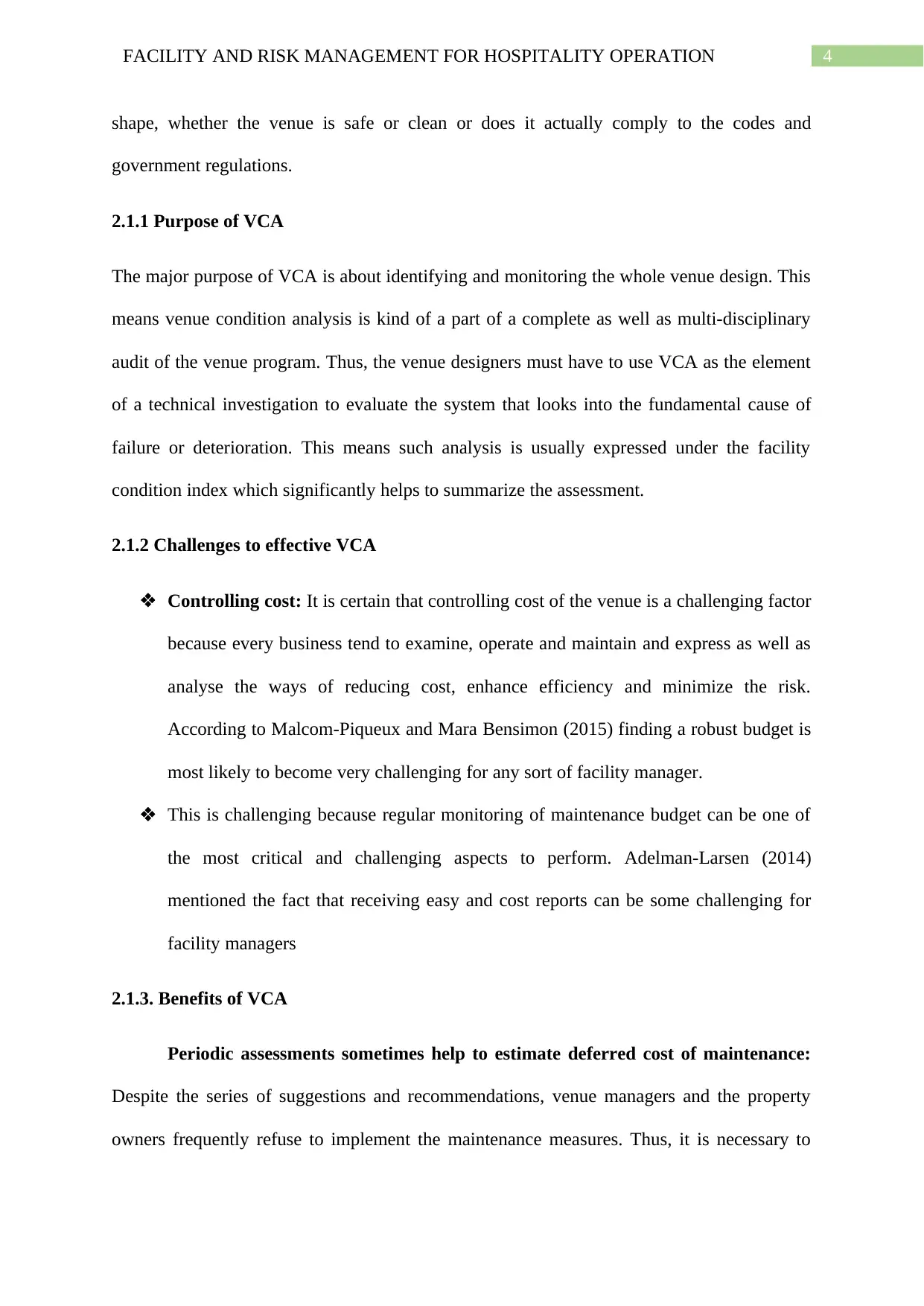
4FACILITY AND RISK MANAGEMENT FOR HOSPITALITY OPERATION
shape, whether the venue is safe or clean or does it actually comply to the codes and
government regulations.
2.1.1 Purpose of VCA
The major purpose of VCA is about identifying and monitoring the whole venue design. This
means venue condition analysis is kind of a part of a complete as well as multi-disciplinary
audit of the venue program. Thus, the venue designers must have to use VCA as the element
of a technical investigation to evaluate the system that looks into the fundamental cause of
failure or deterioration. This means such analysis is usually expressed under the facility
condition index which significantly helps to summarize the assessment.
2.1.2 Challenges to effective VCA
Controlling cost: It is certain that controlling cost of the venue is a challenging factor
because every business tend to examine, operate and maintain and express as well as
analyse the ways of reducing cost, enhance efficiency and minimize the risk.
According to Malcom-Piqueux and Mara Bensimon (2015) finding a robust budget is
most likely to become very challenging for any sort of facility manager.
This is challenging because regular monitoring of maintenance budget can be one of
the most critical and challenging aspects to perform. Adelman-Larsen (2014)
mentioned the fact that receiving easy and cost reports can be some challenging for
facility managers
2.1.3. Benefits of VCA
Periodic assessments sometimes help to estimate deferred cost of maintenance:
Despite the series of suggestions and recommendations, venue managers and the property
owners frequently refuse to implement the maintenance measures. Thus, it is necessary to
shape, whether the venue is safe or clean or does it actually comply to the codes and
government regulations.
2.1.1 Purpose of VCA
The major purpose of VCA is about identifying and monitoring the whole venue design. This
means venue condition analysis is kind of a part of a complete as well as multi-disciplinary
audit of the venue program. Thus, the venue designers must have to use VCA as the element
of a technical investigation to evaluate the system that looks into the fundamental cause of
failure or deterioration. This means such analysis is usually expressed under the facility
condition index which significantly helps to summarize the assessment.
2.1.2 Challenges to effective VCA
Controlling cost: It is certain that controlling cost of the venue is a challenging factor
because every business tend to examine, operate and maintain and express as well as
analyse the ways of reducing cost, enhance efficiency and minimize the risk.
According to Malcom-Piqueux and Mara Bensimon (2015) finding a robust budget is
most likely to become very challenging for any sort of facility manager.
This is challenging because regular monitoring of maintenance budget can be one of
the most critical and challenging aspects to perform. Adelman-Larsen (2014)
mentioned the fact that receiving easy and cost reports can be some challenging for
facility managers
2.1.3. Benefits of VCA
Periodic assessments sometimes help to estimate deferred cost of maintenance:
Despite the series of suggestions and recommendations, venue managers and the property
owners frequently refuse to implement the maintenance measures. Thus, it is necessary to
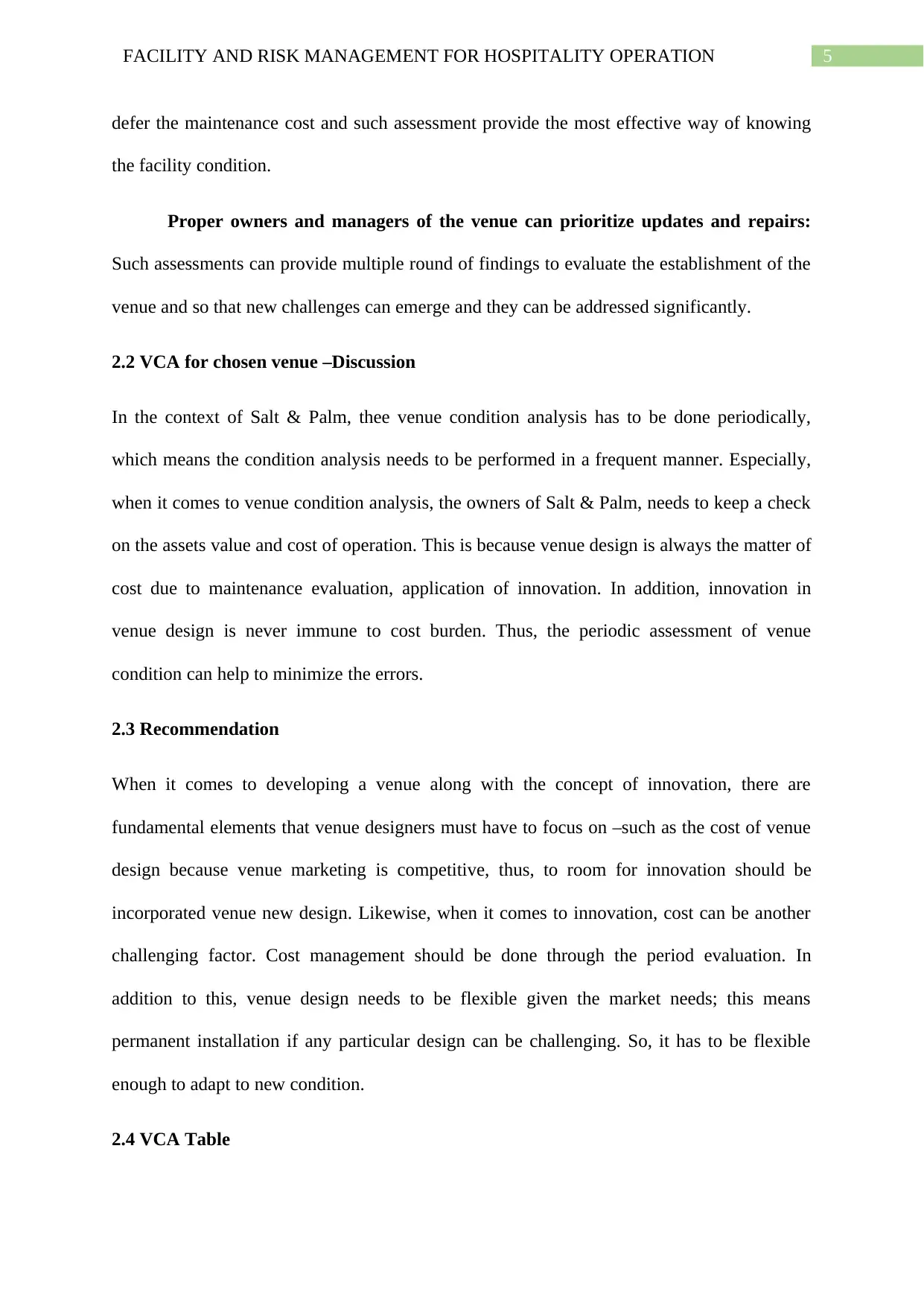
5FACILITY AND RISK MANAGEMENT FOR HOSPITALITY OPERATION
defer the maintenance cost and such assessment provide the most effective way of knowing
the facility condition.
Proper owners and managers of the venue can prioritize updates and repairs:
Such assessments can provide multiple round of findings to evaluate the establishment of the
venue and so that new challenges can emerge and they can be addressed significantly.
2.2 VCA for chosen venue –Discussion
In the context of Salt & Palm, thee venue condition analysis has to be done periodically,
which means the condition analysis needs to be performed in a frequent manner. Especially,
when it comes to venue condition analysis, the owners of Salt & Palm, needs to keep a check
on the assets value and cost of operation. This is because venue design is always the matter of
cost due to maintenance evaluation, application of innovation. In addition, innovation in
venue design is never immune to cost burden. Thus, the periodic assessment of venue
condition can help to minimize the errors.
2.3 Recommendation
When it comes to developing a venue along with the concept of innovation, there are
fundamental elements that venue designers must have to focus on –such as the cost of venue
design because venue marketing is competitive, thus, to room for innovation should be
incorporated venue new design. Likewise, when it comes to innovation, cost can be another
challenging factor. Cost management should be done through the period evaluation. In
addition to this, venue design needs to be flexible given the market needs; this means
permanent installation if any particular design can be challenging. So, it has to be flexible
enough to adapt to new condition.
2.4 VCA Table
defer the maintenance cost and such assessment provide the most effective way of knowing
the facility condition.
Proper owners and managers of the venue can prioritize updates and repairs:
Such assessments can provide multiple round of findings to evaluate the establishment of the
venue and so that new challenges can emerge and they can be addressed significantly.
2.2 VCA for chosen venue –Discussion
In the context of Salt & Palm, thee venue condition analysis has to be done periodically,
which means the condition analysis needs to be performed in a frequent manner. Especially,
when it comes to venue condition analysis, the owners of Salt & Palm, needs to keep a check
on the assets value and cost of operation. This is because venue design is always the matter of
cost due to maintenance evaluation, application of innovation. In addition, innovation in
venue design is never immune to cost burden. Thus, the periodic assessment of venue
condition can help to minimize the errors.
2.3 Recommendation
When it comes to developing a venue along with the concept of innovation, there are
fundamental elements that venue designers must have to focus on –such as the cost of venue
design because venue marketing is competitive, thus, to room for innovation should be
incorporated venue new design. Likewise, when it comes to innovation, cost can be another
challenging factor. Cost management should be done through the period evaluation. In
addition to this, venue design needs to be flexible given the market needs; this means
permanent installation if any particular design can be challenging. So, it has to be flexible
enough to adapt to new condition.
2.4 VCA Table
⊘ This is a preview!⊘
Do you want full access?
Subscribe today to unlock all pages.

Trusted by 1+ million students worldwide
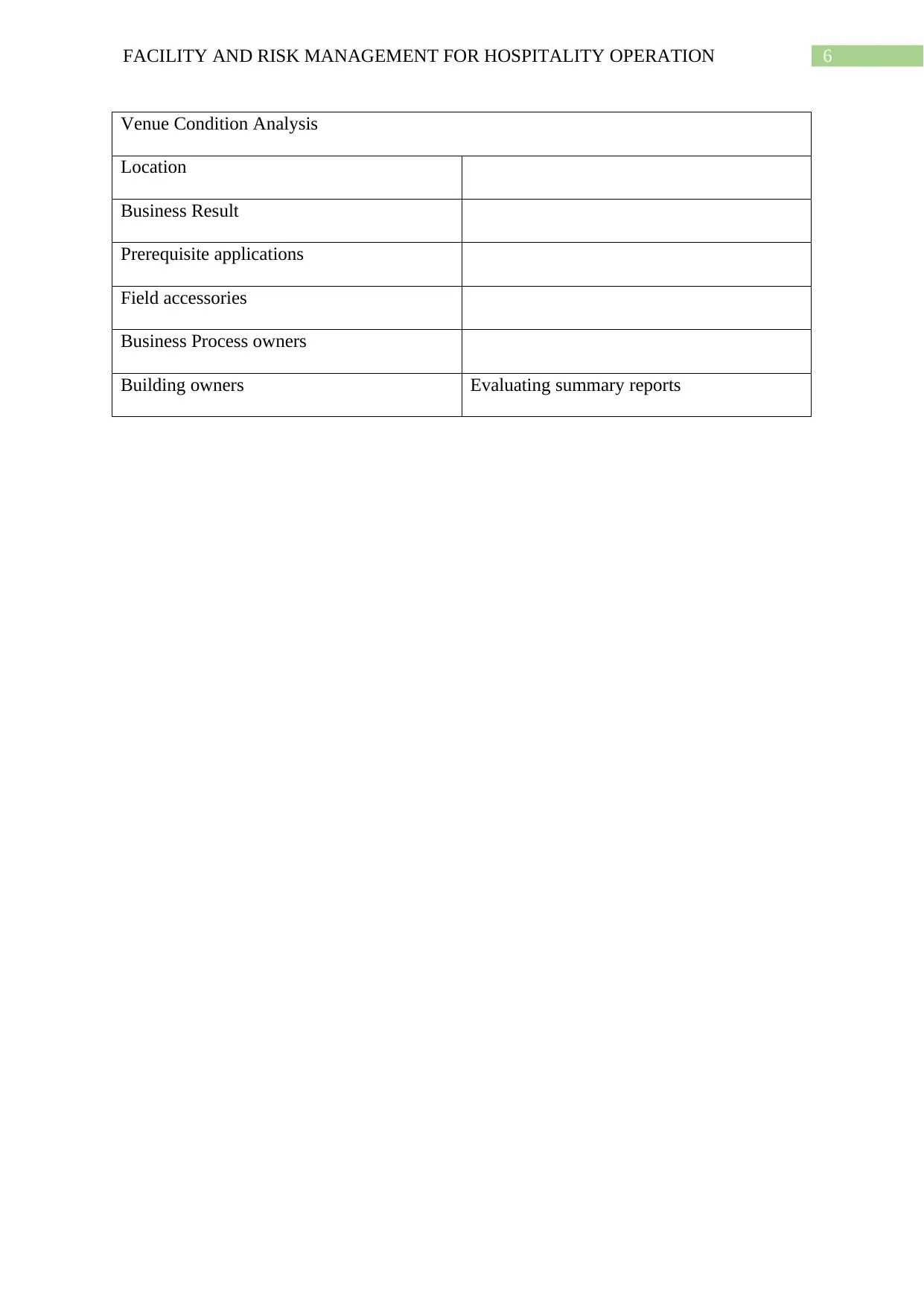
6FACILITY AND RISK MANAGEMENT FOR HOSPITALITY OPERATION
Venue Condition Analysis
Location
Business Result
Prerequisite applications
Field accessories
Business Process owners
Building owners Evaluating summary reports
Venue Condition Analysis
Location
Business Result
Prerequisite applications
Field accessories
Business Process owners
Building owners Evaluating summary reports
Paraphrase This Document
Need a fresh take? Get an instant paraphrase of this document with our AI Paraphraser
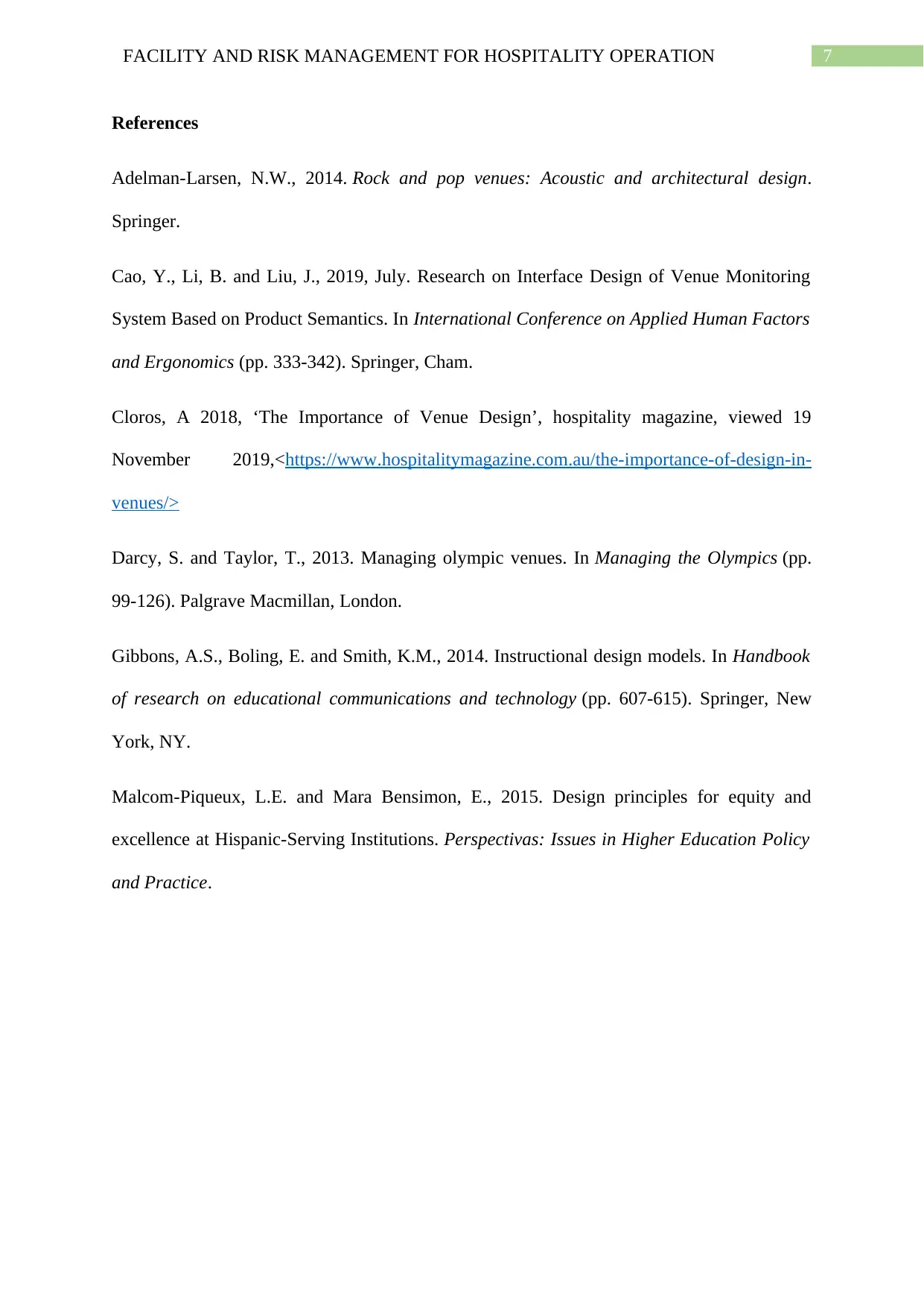
7FACILITY AND RISK MANAGEMENT FOR HOSPITALITY OPERATION
References
Adelman-Larsen, N.W., 2014. Rock and pop venues: Acoustic and architectural design.
Springer.
Cao, Y., Li, B. and Liu, J., 2019, July. Research on Interface Design of Venue Monitoring
System Based on Product Semantics. In International Conference on Applied Human Factors
and Ergonomics (pp. 333-342). Springer, Cham.
Cloros, A 2018, ‘The Importance of Venue Design’, hospitality magazine, viewed 19
November 2019,<https://www.hospitalitymagazine.com.au/the-importance-of-design-in-
venues/>
Darcy, S. and Taylor, T., 2013. Managing olympic venues. In Managing the Olympics (pp.
99-126). Palgrave Macmillan, London.
Gibbons, A.S., Boling, E. and Smith, K.M., 2014. Instructional design models. In Handbook
of research on educational communications and technology (pp. 607-615). Springer, New
York, NY.
Malcom-Piqueux, L.E. and Mara Bensimon, E., 2015. Design principles for equity and
excellence at Hispanic-Serving Institutions. Perspectivas: Issues in Higher Education Policy
and Practice.
References
Adelman-Larsen, N.W., 2014. Rock and pop venues: Acoustic and architectural design.
Springer.
Cao, Y., Li, B. and Liu, J., 2019, July. Research on Interface Design of Venue Monitoring
System Based on Product Semantics. In International Conference on Applied Human Factors
and Ergonomics (pp. 333-342). Springer, Cham.
Cloros, A 2018, ‘The Importance of Venue Design’, hospitality magazine, viewed 19
November 2019,<https://www.hospitalitymagazine.com.au/the-importance-of-design-in-
venues/>
Darcy, S. and Taylor, T., 2013. Managing olympic venues. In Managing the Olympics (pp.
99-126). Palgrave Macmillan, London.
Gibbons, A.S., Boling, E. and Smith, K.M., 2014. Instructional design models. In Handbook
of research on educational communications and technology (pp. 607-615). Springer, New
York, NY.
Malcom-Piqueux, L.E. and Mara Bensimon, E., 2015. Design principles for equity and
excellence at Hispanic-Serving Institutions. Perspectivas: Issues in Higher Education Policy
and Practice.
1 out of 8
Related Documents
Your All-in-One AI-Powered Toolkit for Academic Success.
+13062052269
info@desklib.com
Available 24*7 on WhatsApp / Email
![[object Object]](/_next/static/media/star-bottom.7253800d.svg)
Unlock your academic potential
Copyright © 2020–2025 A2Z Services. All Rights Reserved. Developed and managed by ZUCOL.




